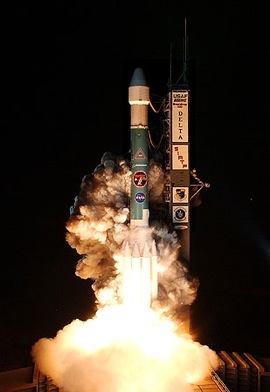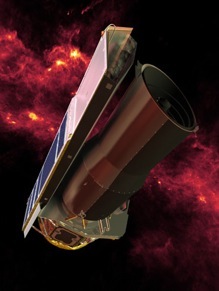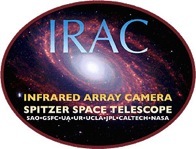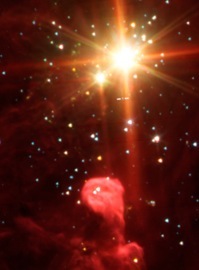The Spitzer Space Telescope and IRAC

Spitzer is the last of NASA “Great Space Observatories” (the others are the Hubble Space Telescope, the Chandra X-Ray and the Compton Gamma-Ray Observatories). Launched into space by a Delta rocket from Cape Canaveral, Florida, on 25 August 2003, it is currently orbiting the Sun in a “Earth Trailing Orbit”. With its 85 cm primary mirror, cryogenically cooled by a reservoir of LHe, Spitzer is the largest infrared telescope ever launched into space.
Infrared light, or heat energy, allows studying the properties of cool astronomical objects through their thermal emissions, like cool stars, brown dwarfs and extrasolar planets. In addition, infrared radiation can penetrate the screen of dust pervading our galaxy: this means that in the infrared we can study regions of space that we cannot see in visible light, such as the dusty center of our galaxy or newly formed stars still embedded in their dusty cocoons. These observations are severely limited from the ground, because water vapour in Earth's atmosphere absorbes much of the infrared radiation. Spitzer, on the other end, takes advantage of the exceptionally stable and cool environment of deep space, which results in unprecedented sensitivity and image quality.

-
‣the InfraRed Array Camera (IRAC), a four channels imager operating at 3.6, 4.5, 5.8 and 8.0 μm. Each channel has a spectral resolution between ~3 and 5, a field of view of ~5 arcmin and a spatial resolution of ~2 arcsec.
-
‣the InfraRed Spectrograph (IRS), capable to collect spectra between 5.2 and 38 μm with a spectral resolution R~60-600. IRS has also two smal imaging subarrays operating at 16 and 22 μm.
-
‣the Multiband Imaging Photometer for Spitzer (MIPS), producing images at 24, 70 and 160 μm and Spectral Energy Distributions (SEDs) between 55 and 95 μm with a spectral resolution R~10.


IRAC was built by the NASA Goddard Space

Calibration of the IRAC extended PRF
As part of the IRAC science team at SAO I have participated in the calibration, test and scientific verification of the camera during the In-Orbit Checkout (IOC) and Science Verification. Since then, I have worked on the characterization of IRAC long lived latents, and the IRAC High Dynamic range Point Response Function (PRF).

This characterization of the IRAC PRF is extremely important because it allows the scientific analysis of data taken in presence of very bright objects:
-
‣ by comparing the intensity of the structures in the HDR PSF with the ones of saturated sources (sources brighter than the maximum allowed flux that can be registered by the detectors) it is still possible to measure their flux;
-
‣ by subtracting a careful aligned and rescaled HDR PSF from the image of a bright point source it is possible to remove a large fraction of its scattered flux, and then search for emission of fainter nearby objects.
For examples of these two techniques in action, see: characterization of AGB stars with IRAC and the search of planetary mass companions around ε Eridani.

The IRAC High Dynamic Range PRF (Marengo et al., 2006 [2])

For more information:
[1] The Infrared Array Camera (IRAC) for the Spitzer Space Telescope, Fazio, G.G. et al. 2004, ApJS 154, 10
[2] A Spitzer/IRAC Search for Substellar Companions of the Debris Disk Star ε Eridani, Marengo, M., et al. 2006, ApJ 647, 1437
[3] Post-BCD Pipeline Processing Software Suite for Spitzer/IRAC Data, Schuster, M., Marengo, M., Patten, B. 2006, SPIE Meeting, Orlando, #6720-65
